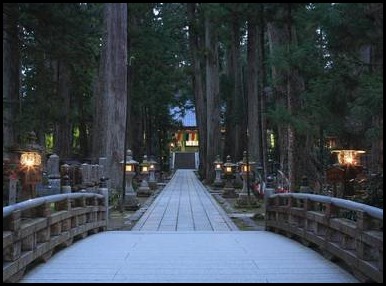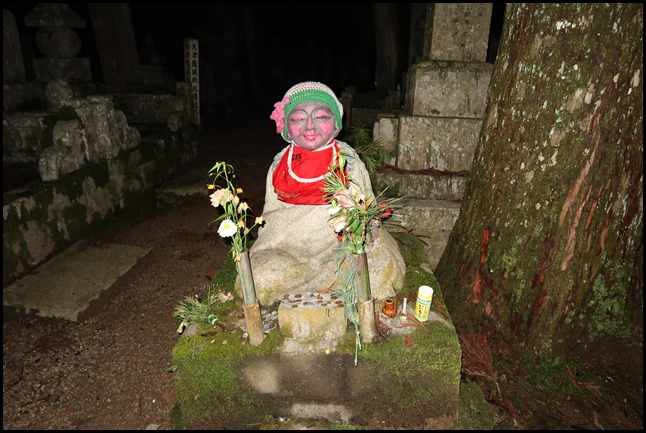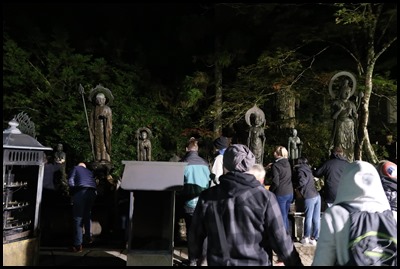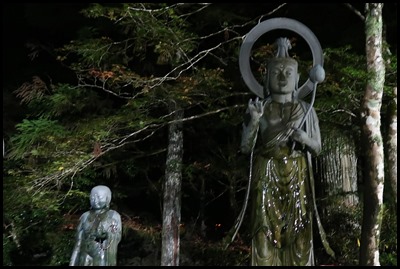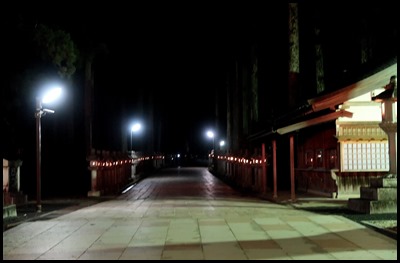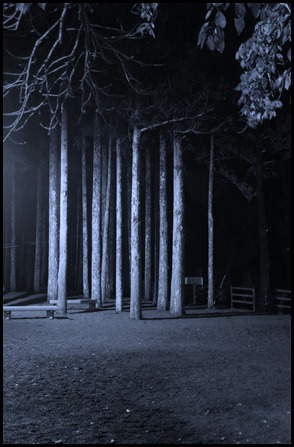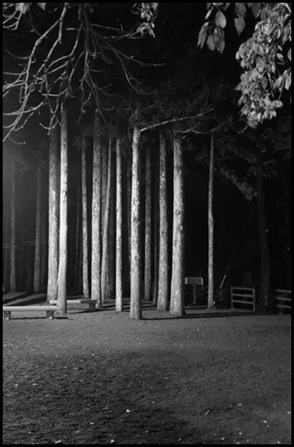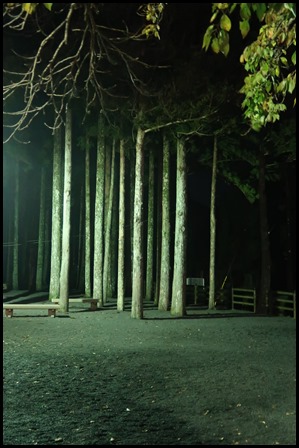Night Cemetery Tour

|
Okunoin Cemetery - Night Tour
with a Young Monk Called Nob
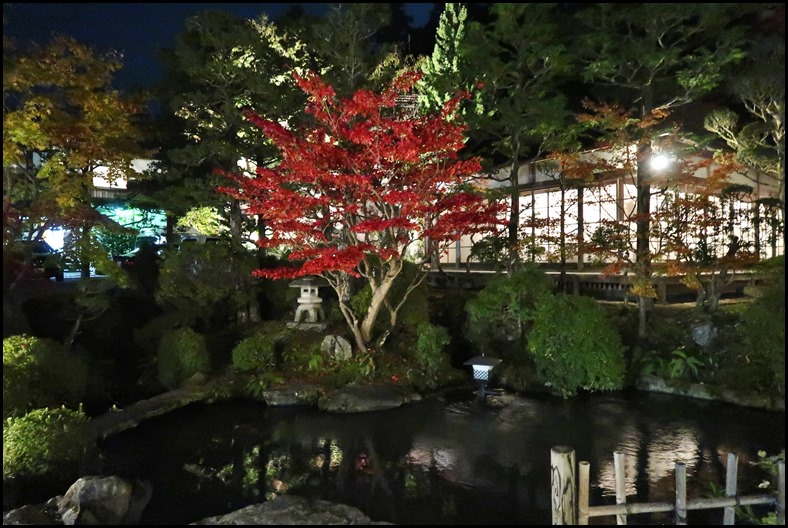 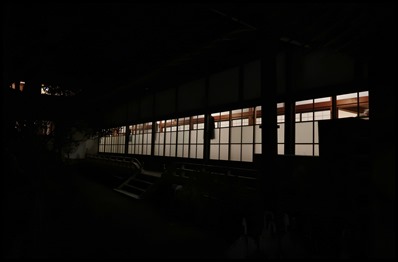 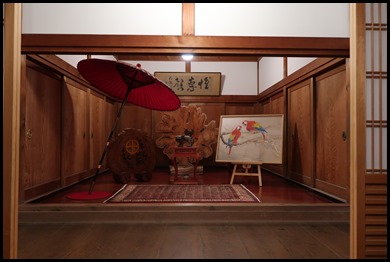 We stand outside Ekoin Temple and wait for our night tour of the biggest
cemetery in Japan that has an entrance a short distance away on the other side
of the road and an exit just down the hill from our digs. Others gather for the
English tour wondering what we are all doing standing on this really cold night.
Dosho, Kobo Daishi's own disciple, built Ekoin almost 1200 years ago. "Eko"
originally means "Transference of Merit."
Our guide appears, “I’m a monk here, my name is Nob spelt
n-o-b”, we like him already.
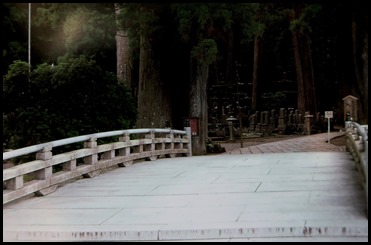 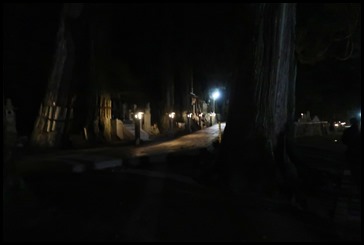 We cross the road and Nob tells us
“we are crossing the Ichi-no-Hashi or bridge at the
start. Prior to crossing this bridge, monks purify their bodies and minds, and
pray here”. Ahead we see rows of lanterns, these will
light our way along the 1.9 kilometre path paid for (prior to his death) by a
man who ran restaurants with many geisha in attendance. Nob tells us “anyone of
any religion can come in here as residents, great, poor, rich, simply
anyone”.
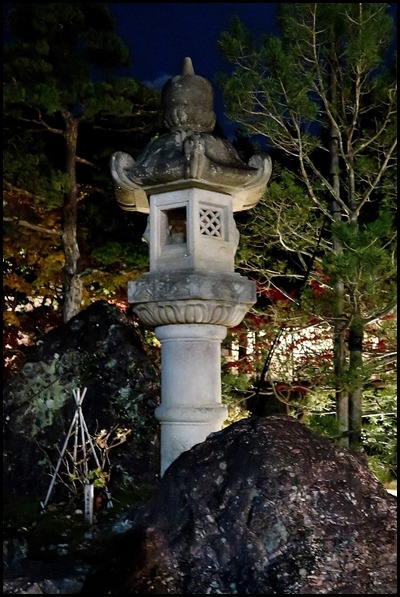 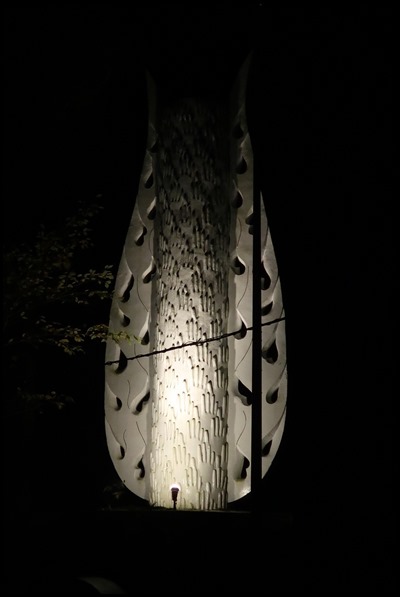 We pass a noble-looking lantern and
see our first memorial for students who died in
battle during WWII.
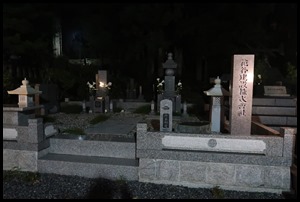 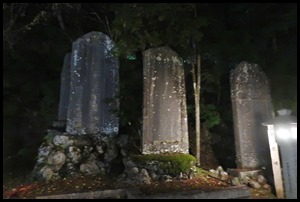 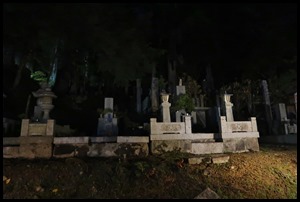 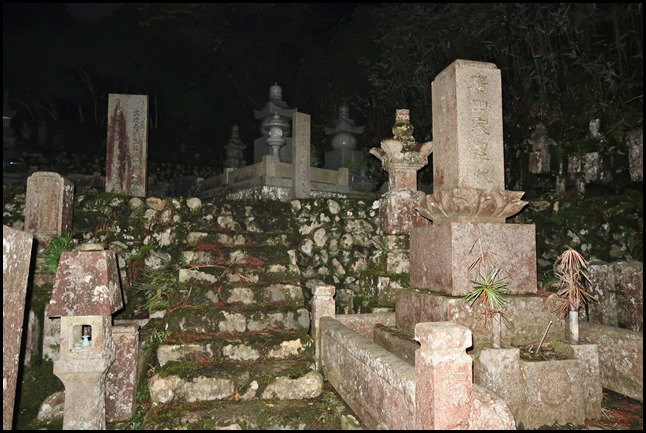 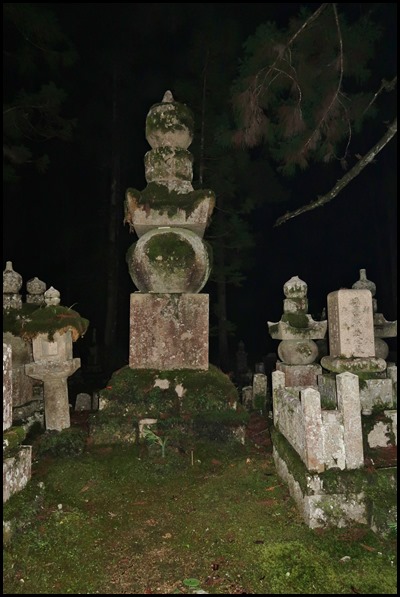 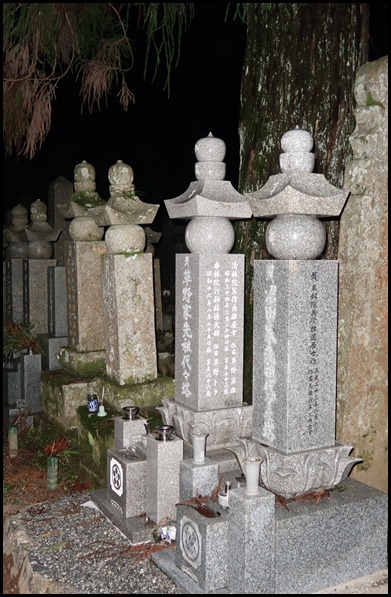 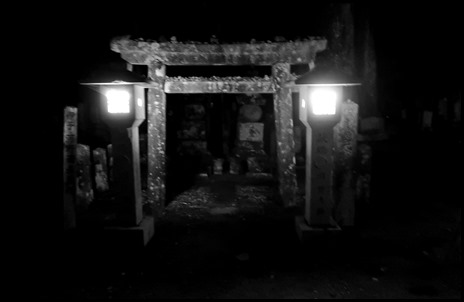 If we shut our eyes and open them, turn in any direction and
do the same, there are simply hundreds of markers. Torii
gates, lanterns and markers with huge cryptomeria trees that Nob tells us
are centuries old. He also says that Japanese people “jump religions through
their lives”. People are born into the Shinto faith, which is all about birth.
Get married as Christians because the ladies prefer the white, Western wedding
dresses and die as Buddhists, which is all about the
afterlife.
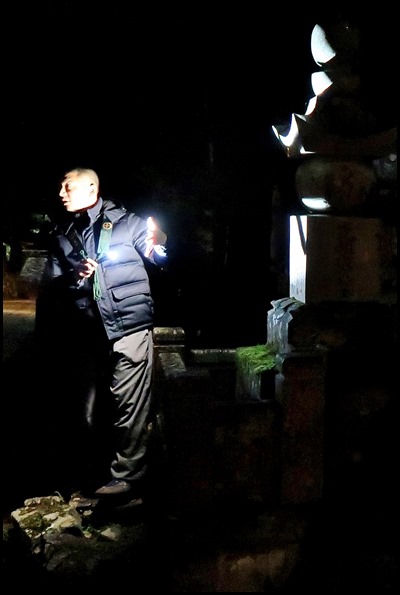 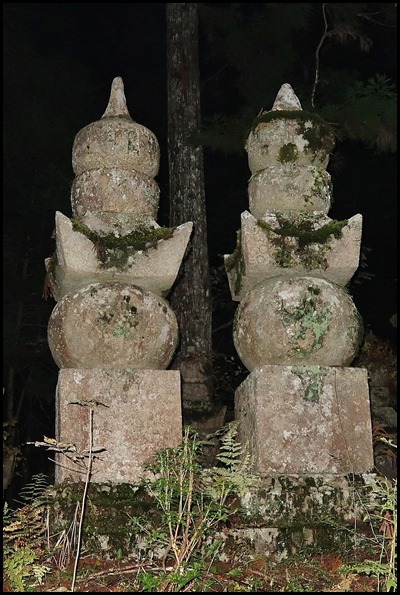 Nob stops and using his torch points to the five shapes of the tombstones. Earth, water, fire, water, air
and ether.
Later I look it up on Wiki: Gorintō: In
all its variations, the gorintō
includes five rings (although that number can often be difficult to detect by
decoration), each having one of the five shapes symbolic of the Five Elements,
(Mahabhuta
in Sanskrit,
or Godai
in Japanese): the earth ring (cube), the water ring (sphere), the fire ring
(pyramid), the air ring (crescent), and the ether ring, (or energy, or
void). The last two rings (air and ether) are visually and conceptually
united into a single subgroup. The last shape, ether, is the one that changes
most according to the country, and in Japan it's close to that of a lotus
flower. The rings express the idea that after death our physical bodies
will go back to their original, elemental form. Gorintō
are usually made of stone, but some built in wood, metal, or crystal
exist.
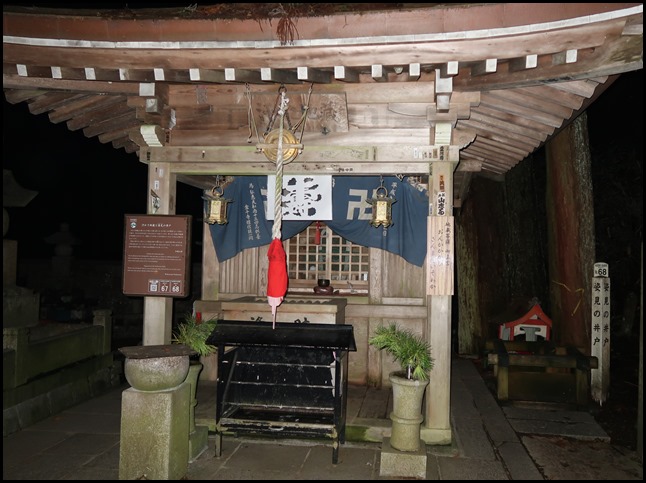 He
introduces us to “Sweaty”. You stand in front of this shrine with ailments and
pray to the Sweating
Jizo, who drips with sweat when taking on the pain and suffering of the
people. Some shrines to Sweaty apparently drip white or black sweat depending on
if ‘things’ are good or bad.......
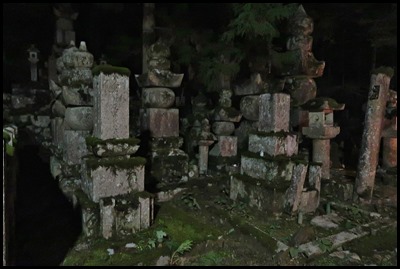 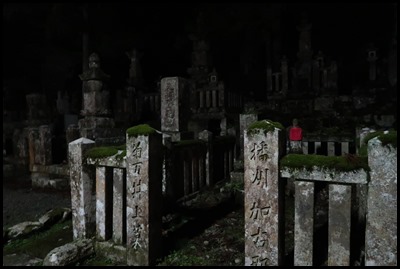 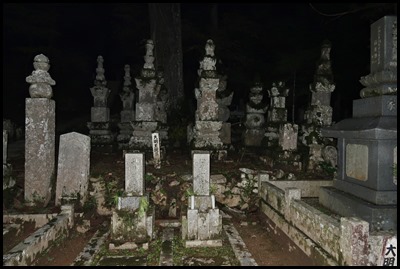 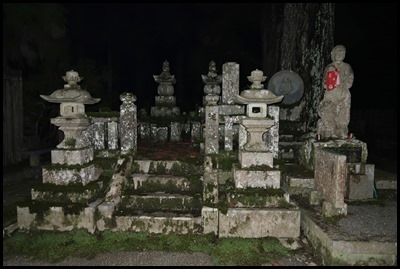 I found the following on a Japanese website and it sums the aura and feelings of the evening, I have shoved in some pictures at pertinent points: According to the superstition of the Shingon Buddhist school, there are no dead in Okunoin, but only waiting spirits. As the story is told, one-day Kukai (774-835), better known in Japan under the name of Kobo Daishi, the founder of the religious community of Mount Koya, came out of meditation upon the arrival of Miroku, the Buddha of the future. So all the souls in transit resting in the graves or of whom the hair or ashes had been placed by their loved ones in front of the Kukai Mausoleum, also rose up. Pending the advent of this apocalyptic prophecy, the number of graves in Okunoin continues to increase and already counts more than two hundred thousand and is the largest cemetery in the archipelago.
A glimpse of the afterlife. Cross the Ichi-no-Hashi bridge, which opens the way to Okunoin is like crossing a bridge between two worlds. Just before, the faithful join hands and bow to show their respect to Kukai. On the other side, the atmosphere is different, the air is charged with the sacred. The dizzying cedars that dot the first graves hide the sky and the end of the paved road that runs up through the wood. The styles of the burial memorials vary too much for the eye to dwell on each of them, but the most spectacular cenotaphs attract attention, such as the one an insecticide company dedicated to its termite victims. Leaving the main path and venturing amid forgotten tombs with eroded stone or covered with moss, allows you to realize that here, Nature has reclaimed its rights. Conversely, the secondary entrance of the cemetery, located across from the Okunoin-mae bus stop, leads to the more recent tombs made with refined granite, as if varnished, artificial, taking away all individuality from their eternal residents. Another sign of modernity, the offerings themselves have changed and soda cans have joined incense and sutras (words attributed to the Buddha or his immediate disciples). Along the main path, do not be surprised by the accessories worn by the statues of Buddhas, who often have a vermilion bib. They are offerings that mothers leave to protect their children in this world or to bring them luck in the afterlife.
The tension mounts. Following the path to the north, after crossing the bridge in the middle, Naka no Hashi, another Gobyo no Hashi, announced the passage into a more advanced level of the sacred. The walkway, of which the thirty-six boards are engraved on the back with Buddhist deities, is itself considered as such. It is necessary to, once again, to bowing with your hand together to invoke Kukai before going across. The area you come to requires the utmost respect. Food, drinks and photographs are not allowed. A little further, on the left, a wooden cabin houses the Miroku stone, which, when lifted weighs the sins of the person. Through small gaps in the walls, it is possible to access the stone and it is customary to try to lift it with one hand to place high up on a shelf. Once you have completed this test, the Toro-do emerges through the trees. This Lantern pavilion houses hundreds of luminous wonders, some of which, according to legend, have been burning unabated for over nine hundred years! A flame in the depths of the night, it is the last building before the holy heart of the cemetery, the ultimate pilgrimage that justifies coming this far into the forest for many devout believers, the eternal dwelling of Kukai.
Here before the final bridge (no more photographs until you re-cross it) was a line of boddhisattvas. We are supposed to wash ourselves in the river but as we are feeble in the freezing cold we are all allowed to scoop up a cupful of water and throw it at our favourite statue. Some were quite dry, others had had a good ol’ drubbing.
"The innermost sanctum" The Okunoin, which is the literal meaning, is above all a place of contemplation. The thousands of graves are eclipsed! By this single sepulchre, which is however inaccessible to ordinary mortals. The Gobyo is said to house the famous Kobo Daishi, who continues to meditate, without a sigh. Each day, meals are deposited at the door in support of his effort, while monks and laymen reflect in silence and recite sutras in a low voice. Everyone is free to represent the venerable one in his cramped interior. Whatever happens, the doors remain closed. Day and night, braving clouds of mosquitoes in summer or gloomy foggy days, visitors flock in all-weather to Okunoin, especially on Obon day, when Rôsoku matsuri takes place and the monks of Koyasan light thousands of candles along the paths. One day is not enough to grasp the its extent and many lives would be necessary to discover all its secrets. Despite this, strangely for a cemetery, its tranquillity soothes the souls of through it. Probably because, impassive in his retreat, Kukai is watching over them. Nob told us the story of a monk who entered the tomb of Kobo Daishi in 910 and cut the long hair and beard of the good man, no one has entered since except for the head monk who pops in once a year.
Over the final bridge we bid ‘farewell’ to Nob and thank him for our wonderful introduction to this magnificent place vowing to be back on the morrow for a longer look and bimble the path not trod tonight. One last look back at a somewhat spooky stand of trees........
ALL IN ALL ANOTHER FIRST AND A UNIQUE ONE FASCINATING AND INTERESTING |
